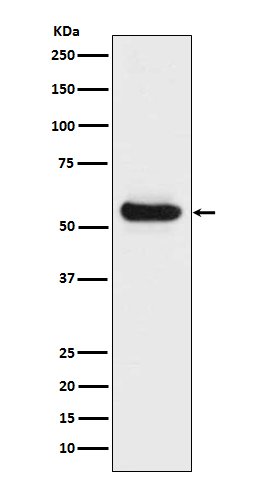Lipoprotein lipase Antibody
Rabbit mAb
- 产品详情
- 实验流程
Application
| WB, IHC |
|---|---|
| Primary Accession | P06858 |
| Reactivity | Human |
| Clonality | Monoclonal |
| Other Names | HDLCQ11; LIPD; Lipoprotein lipase; LPL; LPL protein; |
| Isotype | Rabbit IgG |
| Host | Rabbit |
| Calculated MW | 53162 Da |
| Dilution | WB 1:1000~1:5000 IHC 1:50~1:200 |
|---|---|
| Purification | Affinity-chromatography |
| Immunogen | A synthesized peptide derived from human Lipoprotein lipase |
| Description | The primary function of this lipase is the hydrolysis of triglycerides of circulating chylomicrons and very low density lipoproteins (VLDL). Binding to heparin sulfate proteogylcans at the cell surface is vital to the function. The apolipoprotein, APOC2, acts as a coactivator of LPL activity in the presence of lipids on the luminal surface of vascular endothelium. |
| Storage Condition and Buffer | Rabbit IgG in phosphate buffered saline , pH 7.4, 150mM NaCl, 0.02% sodium azide and 50% glycerol. Store at +4°C short term. Store at -20°C long term. Avoid freeze / thaw cycle. |
| Name | LPL |
|---|---|
| Synonyms | LIPD |
| Function | Key enzyme in triglyceride metabolism. Catalyzes the hydrolysis of triglycerides from circulating chylomicrons and very low density lipoproteins (VLDL), and thereby plays an important role in lipid clearance from the blood stream, lipid utilization and storage (PubMed:11342582, PubMed:27578112, PubMed:8675619). Although it has both phospholipase and triglyceride lipase activities it is primarily a triglyceride lipase with low but detectable phospholipase activity (PubMed:12032167, PubMed:7592706). Mediates margination of triglyceride-rich lipoprotein particles in capillaries (PubMed:24726386). Recruited to its site of action on the luminal surface of vascular endothelium by binding to GPIHBP1 and cell surface heparan sulfate proteoglycans (PubMed:11342582, PubMed:27811232). |
| Cellular Location | Cell membrane {ECO:0000250|UniProtKB:P11151}; Peripheral membrane protein {ECO:0000250|UniProtKB:P11151}; Extracellular side {ECO:0000250|UniProtKB:P11151}. Secreted. Secreted, extracellular space, extracellular matrix. Note=Newly synthesized LPL binds to cell surface heparan proteoglycans and is then released by heparanase Subsequently, it becomes attached to heparan proteoglycan on endothelial cells (PubMed:27811232). Locates to the plasma membrane of microvilli of hepatocytes with triglyceride-rich lipoproteins (TRL) Some of the bound LPL is then internalized and located inside non- coated endocytic vesicles (By similarity) {ECO:0000250|UniProtKB:P11151, ECO:0000269|PubMed:27811232} |
| Tissue Location | Detected in blood plasma (PubMed:11893776, PubMed:12641539, PubMed:2340307). Detected in milk (at protein level) (PubMed:2340307). |
Research Areas
For Research Use Only. Not For Use In Diagnostic Procedures.
Application Protocols
Provided below are standard protocols that you may find useful for product applications.
终于等到您。ABCEPTA(百远生物)抗体产品。
点击下方“我要评价 ”按钮提交您的反馈信息,您的反馈和评价是我们最宝贵的财富之一,
我们将在1-3个工作日内处理您的反馈信息。
如有疑问,联系:0512-88856768 tech-china@abcepta.com.
¥ 1,500.00
Cat# AP91289























 癌症的基本特征包括细胞增殖、血管生成、迁移、凋亡逃避机制和细胞永生等。找到癌症发生过程中这些通路的关键标记物和对应的抗体用于检测至关重要。
癌症的基本特征包括细胞增殖、血管生成、迁移、凋亡逃避机制和细胞永生等。找到癌症发生过程中这些通路的关键标记物和对应的抗体用于检测至关重要。 为您推荐一个泛素化位点预测神器——泛素化分析工具,可以为您的蛋白的泛素化位点作出预测和评分。
为您推荐一个泛素化位点预测神器——泛素化分析工具,可以为您的蛋白的泛素化位点作出预测和评分。 细胞自噬受体图形绘图工具为你的蛋白的细胞受体结合位点作出预测和评分,识别结合到自噬通路中的蛋白是非常重要的,便于让我们理解自噬在正常生理、病理过程中的作用,如发育、细胞分化、神经退化性疾病、压力条件下、感染和癌症。
细胞自噬受体图形绘图工具为你的蛋白的细胞受体结合位点作出预测和评分,识别结合到自噬通路中的蛋白是非常重要的,便于让我们理解自噬在正常生理、病理过程中的作用,如发育、细胞分化、神经退化性疾病、压力条件下、感染和癌症。






